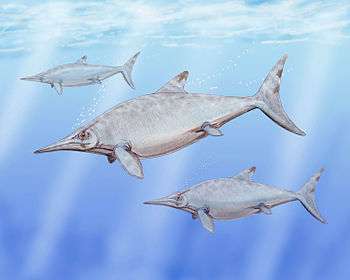Grendelius
| Grendelius Temporal range: Late Jurassic, Kimmeridgian–Tithonian | |
|---|---|
 | |
| Grendelius pseudoscythica | |
| Scientific classification | |
| Kingdom: | Animalia |
| Phylum: | Chordata |
| Class: | Reptilia |
| Order: | †Ichthyosauria |
| Family: | †Ophthalmosauridae |
| Genus: | †Grendelius McGowan, 1976 |
| Species | |
| Synonyms | |
|
Otschevia Efimov, 1998 | |
Grendelius is a genus of platypterygiinae ophthalmosaurid ichthyosaur from the Late Jurassic (Kimmeridgian-Tithonian) of the UK and European Russia.[1]
Taxonomy
The type species, Grendelius morax, was described in 1976 on the basis of CAMSM J.68516, a complete skull with associated postcranial elements from the Kimmeridge Clay of England.[2] Later, it was re-assigned to Brachypterygius because differences between the two species were considered insufficient to warrant separate genera, or even species.[3][4]
Efimov, 1998 named a new genus of ichthyosaur, Otschevia pseudoscythica on the basis of a single specimen (the holotype) from the Pseudoscythia Zone (late Tithonian stage of the Late Jurassic) of Ulyanovsk, Volga region, Russia.[5] Later, Arkangelsky, 1998 described Brachypterygius zhuravlevi from a Tithonian-stage locality in Saratov, Russia, subsequently referring it to Otschevia zhuravlevi.[6][7] Maisch & Matzke, 2000 considered both Russian taxa to be synonyms of each other, and referred the new combination B. pseudoscythica to Brachypterygius, although they misspelt this as B. pseudoscythius.[8] Thus, Grendelius and Otschevia are considered to be junior synonyms of Brachypterygius. Arkhangelsky named Otschevia alekseevi in 2001, also from the Late Jurassic of Russia.[9] While McGowan and Motani (2003) considered these Russian taxa to be junior synonyms of B. extremus,[4] Maisch (2010) retained them, and B. mordax, as separate species.[10] A new paper published in 2015 found Grendelius and Otschevia generically distinct from the Brachypterygius type species and more derived within Platypterygiinae, being more closely related to Platypterygius than to Brachypterygius.[1]
See also
References
- 1 2 N. G. Zverkov, M. S. Arkhangelsky and I. M. Stenshin (2015) A review of Russian Upper Jurassic ichthyosaurs with an intermedium/humeral contact. Reassessing Grendelius McGowan, 1976. Proceedings of the Zoological Institute 318(4): 558-588
- ↑ McGowan C. 1976. The description and phenetic relation-ships of a new ichthyosaur genus from the Upper Jurassic of England. Canadian Journal of Earth Sciences 13: 668–683.
- ↑ McGowan, C. 1997. The taxonomic status of Grendelius mordax: a preliminary report. Journal of Vertebrate Paleontology, 17, 428–430. doi:10.1080/02724634.1997.10010986
- 1 2 McGowan, C. & Motani, R. Ichthyopterygia. In Sues, H.-D. (ed.) Handbook of Paleoherpetology, vol. 8. Verlag Dr. Friedrich Pfeil, Munich, 175 pp., 19 pls.
- ↑ Efimov VM. 1998. An Ichthyosaur, Otschevia pseudoscythica gen. et sp. nov. from the Upper Jurassic Strata of the Ulyanovsk Region (Volga Region). Paleontologicheskii Zhurnal 32 (2): 187-191.
- ↑ Arkhangelsky, M. S. 1998. On the ichthyosaurian fossils from the Volgian stage of the Saratov Region. Paleontologicheskii Zhurnal, 1998, 87–91.
- ↑ Arkhangelsky, M. S. 2000. On the ichthyosaur Otschevia from the Volgian Stage of the Volga Region. Paleontological Journal, 34, 549–552.
- ↑ Maisch MW, Matzke AT. 2000. The Ichthyosauria. Stuttgarter Beiträge zur Naturkunde Serie B (Geologie und Paläontologie) 298: 1-159
- ↑ Arkhangelsky, M. S. 2001. On a new ichthyosaur of the genus Otschevia from the Volgian Stage of the Volga Region near Ulyanovsk. Paleontological Journal, 35, 629–635.
- ↑ Michael W. Maisch (2010). "Phylogeny, systematics, and origin of the Ichthyosauria – the state of the art" (PDF). Palaeodiversity. 3: 151–214.